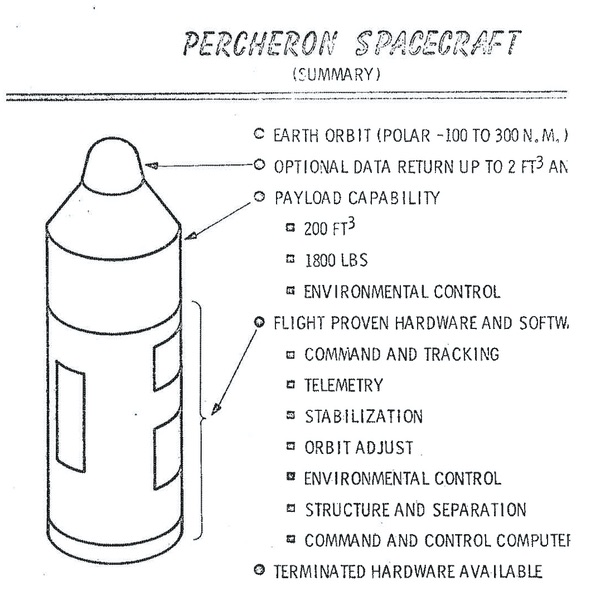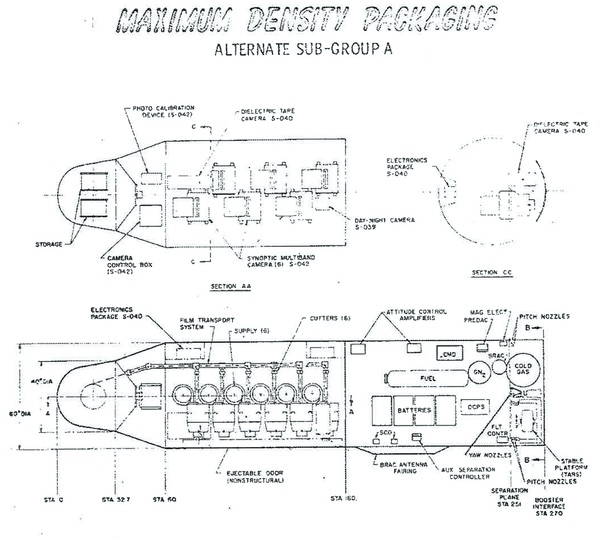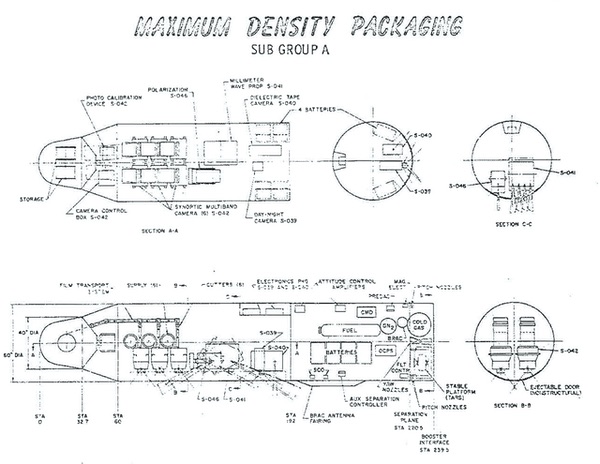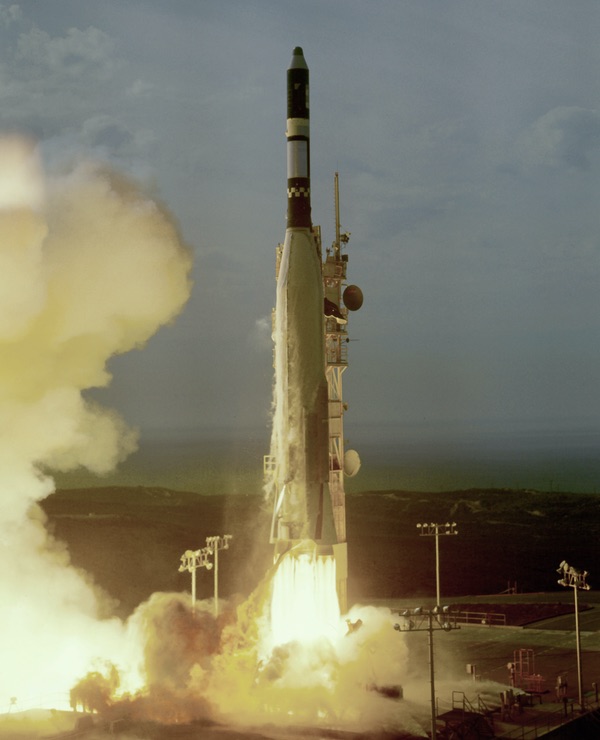Swords into plowshares: the top secret PERCHERON projectby Dwayne A. Day
|
| What General Electric sought to sell was a proven spacecraft supporting a collection of smaller cameras of NASA’s choosing. There was a problem, however: the GAMBIT-1, although obsolete, was still top secret. |
In 1965, the National Reconnaissance Office, which procured and operated reconnaissance satellites to collect intelligence, decided to purchase an upgraded version of the GAMBIT known as the KH-8 GAMBIT-3 (prompting the earlier versions to receive the designation GAMBIT-1). The first GAMBIT-3 launched in 1966, and the GAMBIT-1 was gradually phased out. The camera systems for both versions were made by Eastman Kodak, but the GAMBIT-1 used a spacecraft manufactured by General Electric, and the GAMBIT-3 used a spacecraft made by Lockheed. With the GAMBIT-1 going out of production, General Electric sought to find a new customer for the spacecraft and looked at NASA, which then was operating several remote sensing satellites and looking to improve its capabilities to image the Earth from space.
What General Electric sought to sell was a proven spacecraft supporting a collection of smaller cameras of NASA’s choosing. There was a problem, however: the GAMBIT-1, although obsolete, was still top secret. General Electric could not simply tell NASA officials about it. In September 1966, General Electric personnel approached the leadership of the NRO’s West Coast division, known as the Secretary of the Air Force Special Projects Office, or SAFSP, which many of those involved simply referred to as “special projects.” GE asked for permission to prepare a briefing about the GAMBIT-1 to submit to SAFSP for their approval prior to making any outside contacts about the spacecraft. SAFSP leaders gave them permission, but soon came to regret it.
In October, GE presented the briefing for the PERCHERON proposal which consisted of a general description of the vehicle, general performance capabilities, and possible applications. The briefing also stated that GE had experience and competence with spacecraft. SAFSP approved the briefing but required that GE notify them in advance of who would receive the briefing and require that the entire audience have at least a Secret level security clearance. GE also was forbidden from leaving handouts or any data with the briefing recipients.
To protect existing projects, GE was expressly forbidden from referring to GAMBIT or to SAFSP in its briefings, even to persons who might already have the necessary security clearances. But the name PERCHERON was itself a bit of a giveaway. A Percheron is a breed of draft horse from the former Perche province in western France. Originally bred as war horses, they were later used to pull stagecoaches and farm equipment—going from war horses to plowshares.
By late 1966 or early 1967, GE officials briefed NASA about PERCHERON and then requested permission from SAFSP to provide vehicle briefing specifications to NASA under a Secret classification. SAFSP granted permission provided that a listing of all copies and their NASA recipients be provided to them.
 The PERCHERON spacecraft would have used the basic GAMBIT-1 spacecraft, but equipped with different cameras. General Electric's leadership believed that NASA could use it for Earth remote sensing. But the program was still classified. (credit: NRO) |
The relationship sours
Although it is not known what NRO officials thought of General Electric’s proposal to offer the GAMBIT-1 to NASA, the limited documentation available indicates that at least early on, GE followed SAFSP’s requirements. But by spring of 1967, the two organizations started to butt heads.
By early 1967 only a few remaining GAMBIT-1 vehicles were preparing to fly, one in February followed by two more that would launch in March and June. Two other vehicles did not have scheduled launch dates. There were five more vehicles that did not have Atlas rockets assigned to them. The head of SAFSP, Major General John Martin, recommended to NRO director Al Flax that they terminate work on the last five vehicles and Flax agreed.
| NASA officials were interested in the PERCHERON proposal. It could be available soon, and would be relatively cheap. |
In March 1967, GE forwarded the Special Projects office a copy of the PERCHERON briefing that SAFSP had approved and GE presented to NASA. But following this, GE sent SAFSP additional briefings, including “a rather large volume on the subject,” according to an SAFSP memo, and they had been used in a presentation to NASA in late April. Special Projects officers were apparently annoyed that GE had not cleared this material with SAFSP beforehand.
Also in April, GE requested that the remaining GAMBIT-1 equipment be given to GE for its use in the PERCHERON proposal. SAFSP instructed GE to take an inventory of the remaining equipment with the intention of permitting all NRO programs to screen for any equipment that they might use.
During its late April briefing to the NASA Photo Working Group, which was comprised of representatives from NASA, DoD, and the scientific community, GE officials indicated that the spacecraft were available and the Air Force could launch them for NASA from Vandenberg Air Force Base. GE also indicated that the satellites would be operated by the Air Force’s Satellite Control Facility and the Air Force would also recover the film capsules. GE also gave NASA only three days—until May 1, 1967—to make a decision.
What is not clear based upon available documentation is what the camera setup would be. An undated presentation apparently produced by GE shows several camera configurations for the PERCHERON vehicle. These could include cameras that could operate in different parts of the frequency spectrum. They would mostly be film cameras and the film would be collected in the reentry vehicle at the front of the spacecraft.
NASA officials were interested in the PERCHERON proposal. It could be available soon, and would be relatively cheap. At the time, NASA was planning on starting a NASA Earth Resources Survey Program (NERSP) using a GAMBIT-1 camera carried in a Lockheed—not General Electric—spacecraft and attached to a crewed vehicle serviced by an Apollo spacecraft. That system, known as the Lunar Mapping & Survey System, had originally been developed for mapping landing sites on the Moon, but NASA wanted to use it in Earth orbit as part of NERSP. PERCHERON could possibly perform that mission cheaper and faster. But NASA personnel also believed they needed a month to evaluate the proposal, not the few days that GE had given them.
NASA officials approached SAFSP asking about GE’s decision deadline, any security complications associated with using the spacecraft, and any associated problems with getting the spacecraft launched and its film recovered.
Although the information available about PERCHERON consists of official memos and documents produced by SAFSP, they do not hide the growing annoyance that those in the Special Projects office had toward General Electric, who SAFSP thought was trying to make a “hard sell” to NASA—in other words, backing NASA officials into a corner with a take it or leave it offer. SAFSP informed NASA that the NRO had nothing to do with GE’s short deadline, but believed that it might be because GE was hoping that a commitment from NASA would help GE secure some of the GAMBIT-1 property before other NRO projects laid claim to any of it, thus lowering GE’s costs. This fait accompli did not seem to amuse those at Special Projects.
| Although the information available about PERCHERON consists of official memos and documents produced by SAFSP, they do not hide the growing annoyance that those in the Special Projects office had toward General Electric, who SAFSP thought was trying to make a “hard sell” to NASA. |
The security issue was complicated. There were then four complete GAMBIT-1 vehicles at Vandenberg Air Force Base and two incomplete ones at GE’s manufacturing facility in Pennsylvania. Any vehicles that would be turned over to NASA had to be “sanitized,” something that would also have to be done to all six vehicles if they were to be scheduled for destruction. If they were to be destroyed, however, the Air Force would pay the sanitization cost, but if they were to be turned over to NASA, then that cost would have to be passed on to NASA by General Electric. In addition, NASA would also want historical flight performance and qualification data on the vehicles, which an SAFSP document admitted “would represent more of an irritation than a risk.”
The launch situation was even more complicated. Atlas-Agena launch vehicles were still available. If NASA traded with other programs for a vehicle, one could be available as soon as a few months, but a new one would require 14 months. The bigger problem was the availability of pads at Vandenberg to launch them.
At the time, there were two Atlas-Agena launch pads at Vandenberg. Space Launch Complex-4E—generally referred to as “Slick-4E”—was scheduled for conversion beginning on July 1 to launch the Titan IIID rocket. The other pad, SLC-3E, was going to be placed in “standby status” by January 1, 1968. Reactivating it would require two to three months.
  Two proposals for mounting multiple camera systems inside the PERCHERON spacecraft. NASA was initially interested, but General Electric made promises about hardware that the company did not actually own. (credit: NRO) |
PERCHERON R.I.P.
The NRO responded to NASA’s questions by May 5, after GE’s May 1 deadline to the civilian space agency. NASA officials then mulled the issue for another 11 days before a NASA official contacted the NRO’s Staff in Washington, DC, to seek final clarity on the issue, asking if GE was “peddling a bona fide offer” or would the Air Force “scavenge the remains” of the program? NRO responded that they had no way of knowing if GE was making “a bona fide offer” and because GE had still not provided NRO with a completed property inventory, the NRO had not indicated what leftover hardware it might still claim, making it unavailable for PERCHERON.
On June 20, several NRO officials met with Norman Jaffe of NASA, the person responsible for the agency’s dealings on PERCHERON. By this time, the NRO had launched 38 GAMBIT-1 spacecraft and had no plans to launch any more.
The NRO officials stated that they were merely there to provide facts, not to influence NASA’s contracting decision. But they were rather blunt about those facts. A short memorandum for the record on the meeting laid out the facts as NRO saw them:
“There are only two shells available. These will be ‘sanitized’;
Atlas boosters will be a NASA problem;
There is no launching pad at VAFB for PERCHERON;
The launching and recovery services, which G.E. refers to so casually, are not GE’s to negotiate.”
In response to this information, Jaffe indicated that “he is losing interest in GE.” This was largely because another proposal from Lockheed sounded better to him. Jaffe indicated plans “to run a study competition for 40-60 days between GE and LMSC.”
PERCHERON was dead.
Things fall apart
In later years, NRO officials would occasionally refer to several of their interactions with NASA in less than glowing terms, but PERCHERON appears to have been the most egregious offender. None of the released material indicates that NRO officials were unhappy with NASA over PERCHERON. They were apparently annoyed with General Electric, particularly its sharing of information that had not been approved for sharing, and making promises about property and assets the company did not own.
| Although PERCHERON never flew, it does appear to have played a role in helping NASA better define its requirements for the Earth Remote Sensing Program. |
It was almost inevitable that NRO officials would be uneasy working with NASA. The civilian space agency operated in the glare of public opinion. In contrast, NRO did not publicly exist. NASA officials saw NRO’s optics technology as a shortcut to developing Earth remote sensing capabilities, but NRO officials worried that it would expose their intelligence operations.
According to one former GE engineer, the company’s relationship with the NRO had deteriorated by the late 1960s, so “the PERCHERON debacle,” as one NRO official referred to it, was apparently just one of a series of issues between the company and the NRO.
Indeed, GAMBIT-1 had been a source of problems only a few years earlier. NRO had signed a contract for the spacecraft that awarded GE a performance fee for delivering GAMBIT spacecraft on-time to the Vandenberg launch site, rather than successful operation in orbit. When GE started to fall behind on its schedule, the company began delivering incomplete spacecraft to Vandenberg to finish work on them there and still collect its fee. The finishing work at Vandenberg was not as good as at the factory, and the vehicles started to suffer more malfunctions in orbit.
Although PERCHERON never flew, it does appear to have played a role in helping NASA better define its requirements for the Earth Remote Sensing Program, ultimately leading the agency away from film-based systems to spacecraft that could transmit their data to the ground. Although NASA’s early remote sensing program story has been told, there are clearly some hidden chapters to that saga besides PERCHERON.
Note: we are temporarily moderating all comments submitted to deal with a surge in spam.
